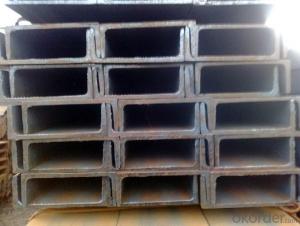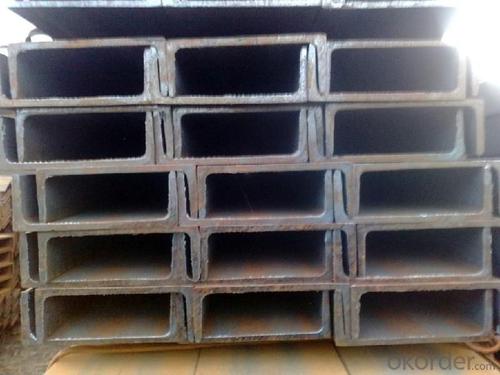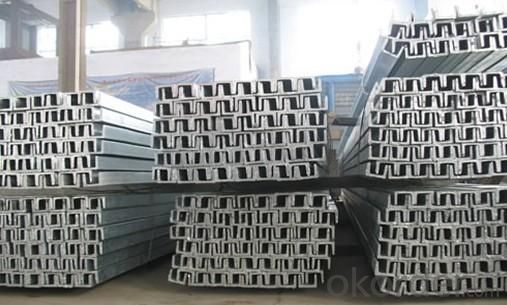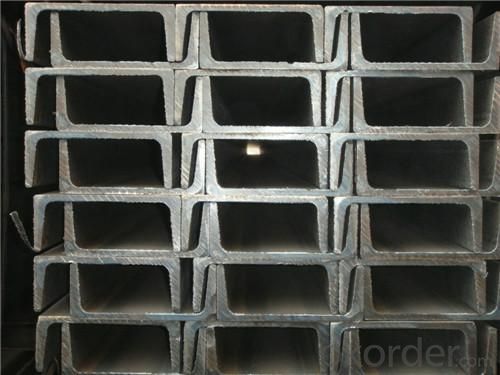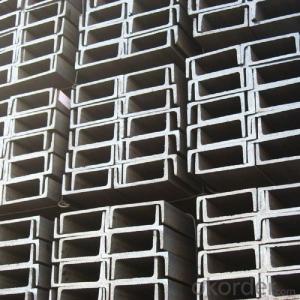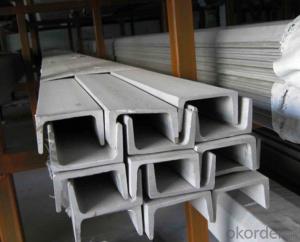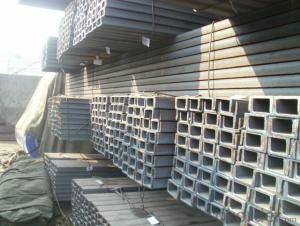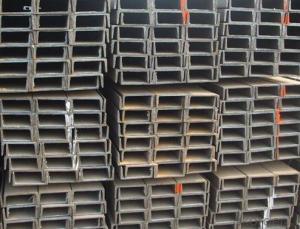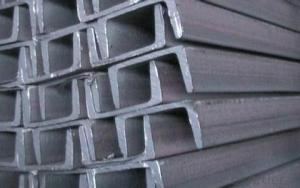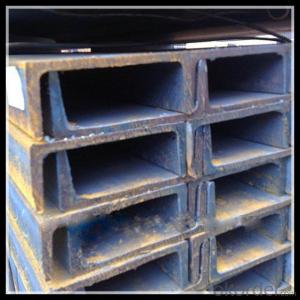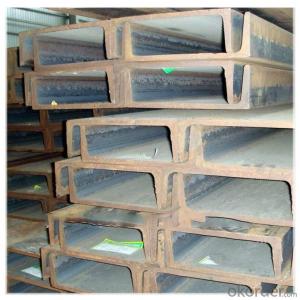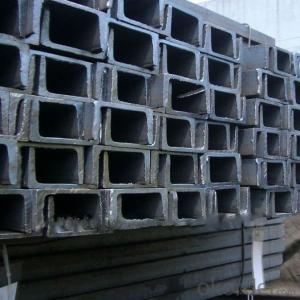channel steel Surface and Length: According to the Requirements
- Loading Port:
- Qingdao
- Payment Terms:
- TT OR LC
- Min Order Qty:
- 15 m.t.
- Supply Capability:
- 500000 m.t./month
OKorder Service Pledge
OKorder Financial Service
You Might Also Like
1、the details information of our Channel Steel
1)the ordinary model
Height: | 90-400mm |
Thickness: | 9-14.5mm |
Surface: | according to the customers’ requirements |
Length: | As customers’ requirements |
Size: | 90*37*4.5mm--400*104*14.5 mm . |
Punch: | Can be punched as customer's drawing |
Material: | Q195/Q235/ Q215/Q345/SS400/S235JR, A36,SS400,SS540 ASTM A36 and so on |
2)the light model
Height: | 90-400mm |
Thickness: | 6.4-8.0mm |
Surface: | Painted or Galvanized;according to the customers’ requirements |
Length: | As customers’ requirements |
Size: | 50*32*4.4mm--400*115*8.0mm . |
Punch: | Can be punched as customer's drawing |
Material: | Q195/Q235/ Q215/Q345/SS400/S235JR, A36,SS400,SS540 ASTM A36 and so on |
2、the Product Advantage
1) We can design the channel steel according to customers’requirements
2) We can manufacture under complete quality control system---ISO9001&SGS
3) We can installed with instruction of experienced engineers
4) Easy to assemble and dismantle
5) Eco-friendly material: can be used for several times and can be recycled
6) Shorter construction period, longer using time
7) High strength and stiffness, high weight bearing
3、why choose us ?Product Advantage
1)The channel steel quality is prime quality
2)Our price is competitive price with our competitor
3)We provide the professional service
4)Prompt delivery & Seaworthy packing
5)Mill Test Certificate
- Q: What are the factors to consider when selecting the appropriate steel grade for a channel?
- When choosing the right steel grade for a channel, there are several factors that need to be taken into account. Firstly, the specific structural requirements of the channel must be considered. This includes determining the load-bearing capacity, stiffness, and durability needed for the intended application. Different steel grades possess varying strengths and properties, so it is crucial to select a grade that meets the channel's structural requirements. Secondly, the level of corrosion resistance required should be considered, depending on the environment in which the channel will be utilized. If the channel is going to be exposed to corrosive environments like coastal areas or chemical plants, it may be necessary to opt for steel grades with higher levels of corrosion resistance, such as stainless steel. Next, if the channel will undergo welding, it is important to take into account the weldability of the steel grade. Some steel grades have better weldability than others, and this can have an impact on the ease and quality of the welding process. To ensure the integrity of the channel, it is essential to choose a steel grade that can be easily welded. Cost is another significant factor to consider when selecting a steel grade. Different steel grades come with different costs, so it is important to consider the budget constraints of the project. However, it is crucial to strike a balance between cost and the aforementioned factors to ensure the appropriate steel grade is chosen. Lastly, the availability of the steel grade should be taken into consideration. The accessibility of certain steel grades may vary, which can affect the timeline and logistics of the project. To ensure the timely completion of the project, it is important to choose a steel grade that is easily accessible. In conclusion, when choosing the right steel grade for a channel, it is important to consider the structural requirements, corrosion resistance, weldability, cost, and availability. By carefully evaluating these factors, one can make an informed decision and select the most suitable steel grade for their specific needs.
- Q: Can steel channels be used for solar panel racking systems?
- Yes, steel channels can be used for solar panel racking systems. They provide a strong and durable framework for mounting and securing solar panels, making them a popular choice in the industry. The versatility and structural integrity of steel channels make them suitable for supporting the weight of solar panels while withstanding various weather conditions.
- Q: Can steel channels be used for residential construction projects?
- Yes, steel channels can be used for residential construction projects. Steel channels are commonly used in construction due to their strength, durability, and versatility. They are often used for framing, support structures, and other applications in residential buildings.
- Q: How long can steel channels last?
- Steel channels can last for several decades to even centuries, depending on various factors such as the quality of the steel, the environmental conditions, and the maintenance and care taken.
- Q: How do steel channels contribute to the overall sustainability of a project?
- There are multiple ways in which steel channels contribute to the overall sustainability of a project. To begin with, steel is an incredibly durable and long-lasting material, meaning that steel channels can withstand the test of time and require minimal maintenance or replacement. As a result, the overall resource consumption and waste generation associated with a project are reduced. In addition, steel channels are recyclable, allowing them to be melted down and reused once they reach the end of their lifespan. This helps to decrease the demand for raw materials and the energy required for manufacturing new steel products, thereby reducing the environmental impact of a project. Moreover, steel channels possess the unique combination of being lightweight and strong, making them ideal for efficient design and construction. Consequently, material usage and transportation costs are reduced, as well as energy consumption during the construction phase. This aspect of steel channels contributes to the overall sustainability of a project by minimizing the carbon footprint and resource depletion associated with the construction process. Furthermore, steel is a non-combustible material, making it a safe choice for projects in terms of fire resistance. This enhances the overall safety and resilience of the project, reducing the risk of damage or destruction and minimizing the need for repairs or reconstruction. Lastly, steel channels offer great versatility in design and construction, enabling innovative and efficient solutions. This flexibility empowers architects and engineers to optimize the use of materials, space, and energy, resulting in sustainable and eco-friendly designs. Overall, steel channels contribute to the overall sustainability of a project through their durability, recyclability, lightweight yet strong properties, fire resistance, and design versatility. By selecting steel channels, project developers can minimize resource consumption, waste generation, carbon emissions, and overall environmental impact, making their project more sustainable in the long run.
- Q: Can steel channels be used for walkway supports?
- Yes, steel channels can be used for walkway supports. Steel channels are commonly used in construction due to their strength and durability, making them suitable for providing structural support for walkways.
- Q: Can steel channels be used in railway infrastructure projects?
- Yes, steel channels can certainly be used in railway infrastructure projects. Steel channels provide structural support and can be used for various applications such as track support, bridge construction, and platform framing. They offer strength, durability, and the ability to withstand heavy loads, making them suitable for railway projects.
- Q: Can steel channels be used for rooftop installations?
- Rooftop installations can indeed make use of steel channels. Steel channels find wide application in construction, including rooftop installations, as they offer structural support and stability. This makes them a suitable choice for mounting solar panels, air conditioning units, and other rooftop equipment. The durability, strength, and corrosion resistance of steel channels make them an ideal option for outdoor use. Moreover, their versatility allows for effortless customization and adjustment to meet specific rooftop needs.
- Q: Can steel channels be used for stair stringers in commercial buildings?
- Yes, steel channels can be used as stair stringers in commercial buildings. Steel channels are often preferred for their strength, durability, and load-bearing capabilities, making them suitable for supporting staircases in high-traffic areas such as commercial buildings. Additionally, steel channels can be easily fabricated and installed, providing a reliable and long-lasting solution for stair stringers in these settings.
- Q: What are the different types of bending for steel channels?
- Steel channels can be bent using various methods, including cold bending, hot bending, and press brake bending. 1. Cold Bending: To shape the steel channel without heating it, force is applied. This cost-effective method does not necessitate specialized equipment. Manual tools like hammers, pipe benders, or hydraulic benders can be utilized. Cold bending is suitable for simpler and smaller projects. 2. Hot Bending: The steel channel is heated to a specific temperature before being shaped. This technique is employed for more complex and larger bending projects, as it allows for precise and controlled bending. Induction heating or flame heating techniques are commonly used. After heating, hydraulic or mechanical force is applied to bend the steel channel. 3. Press Brake Bending: A press brake machine is employed in this method. It is highly accurate and ideal for large-scale production. The machine consists of a punch and a die. The steel channel is positioned between the punch and the die, and force is applied using the press brake to achieve the desired angle. The choice of bending method depends on factors such as the complexity of the project, the size of the steel channel, and the required precision. Each method has its own advantages and limitations, so it is crucial to select the appropriate method based on these factors to ensure the desired outcome.
Send your message to us
channel steel Surface and Length: According to the Requirements
- Loading Port:
- Qingdao
- Payment Terms:
- TT OR LC
- Min Order Qty:
- 15 m.t.
- Supply Capability:
- 500000 m.t./month
OKorder Service Pledge
OKorder Financial Service
Similar products
Hot products
Hot Searches
Related keywords
